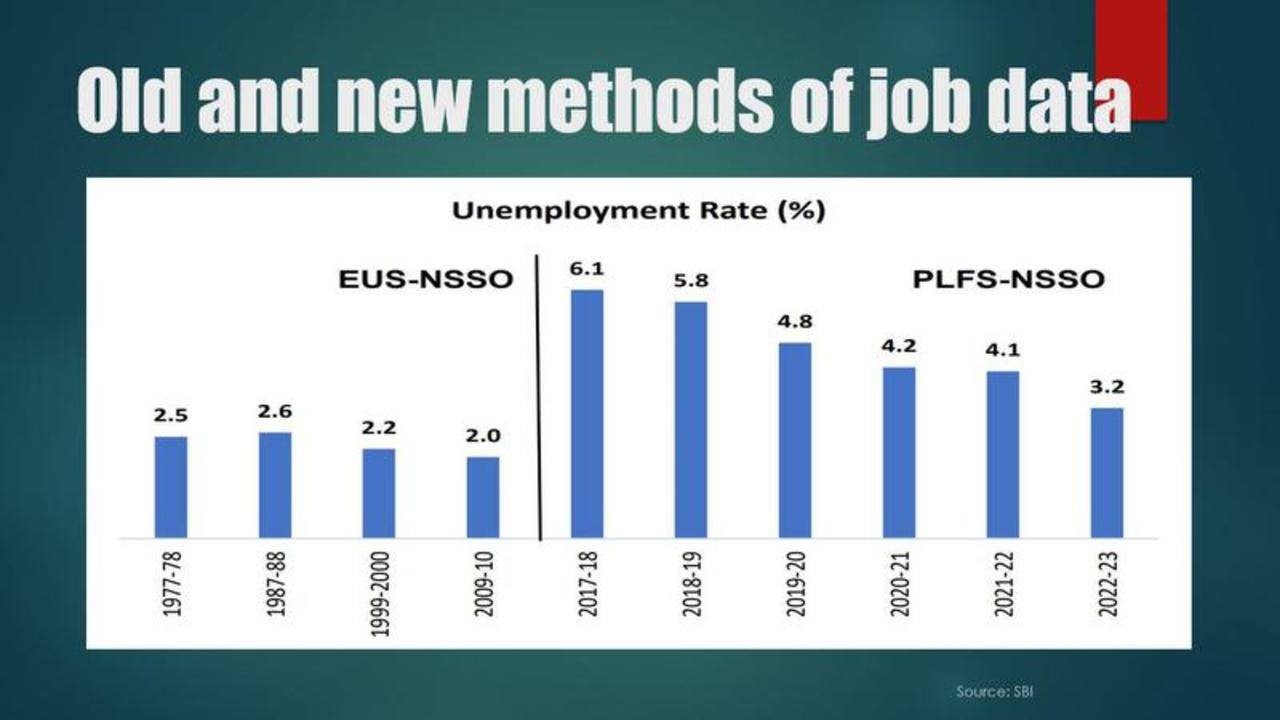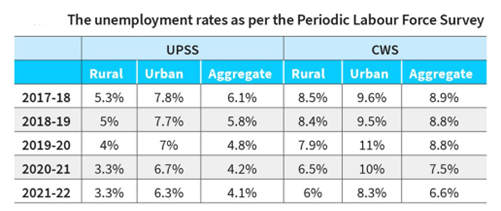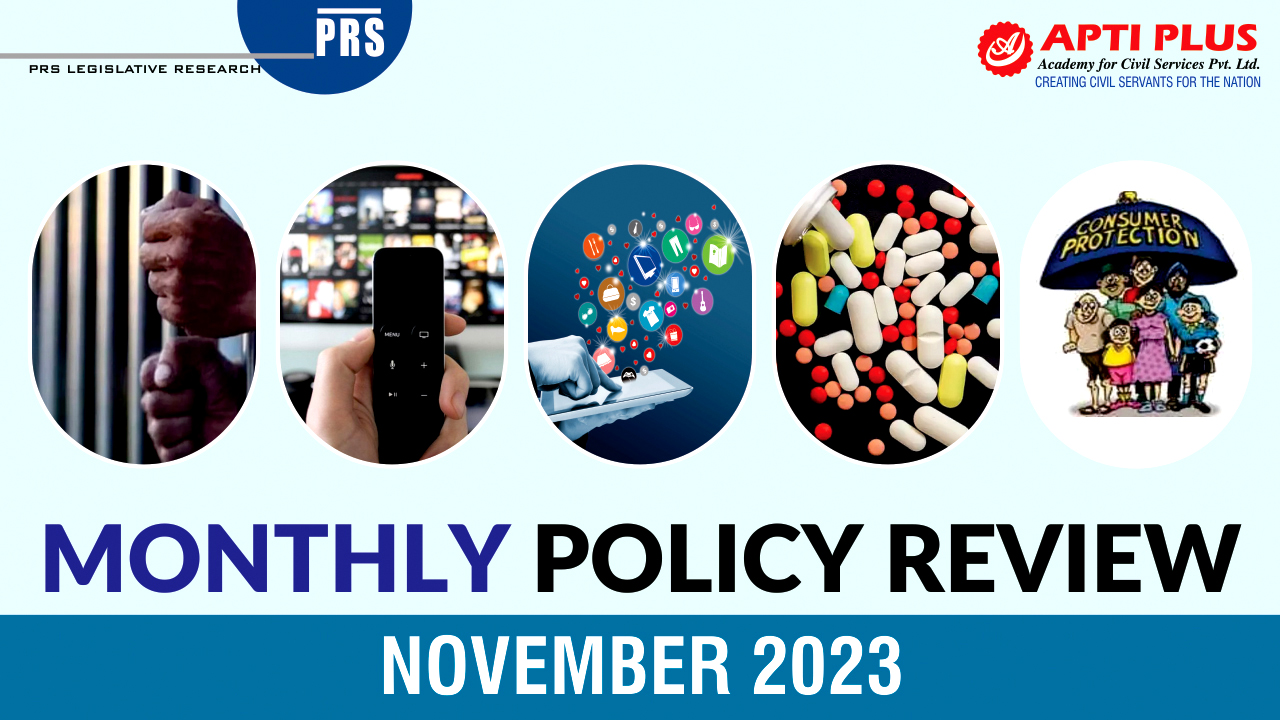PERSPECTIVE: India’s Unemployment Rate At Record Low: SBI Report

Disclaimer: Copyright infringement not intended.
Context
- Latest State Bank of India report says that India’s unemployment rate is at a record low with the labour market altering substantially with self-employment.
Details:
- India’s labor market is undergoing a deep structural transformation with self-entrepreneurship across all sectors.
- Government emphasis on entrepreneurship through Pradhan Mantri MUDRA Yojana and even recent schemes post pandemic like PMSVANidhi for those at the bottom of pyramid is imparting a structural transformation in labor markets in India through the formalization of credit.
| It rued that the jump in the self-employed populace within the employment estimates (57.3 percent in FY23, against 52.2 percent in FY18), with the main traction coming from the rising share of household helpers evidentially, has been wrongfully interpreted by labor economists and others as a signal of shrinking employment opportunities. |
Current Unemployment Rate in India:
Unemployment Challenges Persist in India
- India is grappling with persistent unemployment concerns, marked by fluctuations evident across various regions and sectors.
- According to a recent Bloomberg report citing data from the Centre for Monitoring Indian Economy (CMIE) for July, the national unemployment rate stands at 7.95 percent as of July 2023.
Positive Shift in Urban Employment
- In a positive development, the latest Periodical Labour Force Survey indicates a shift in urban areas, revealing a one percent decrease in the unemployment rate for individuals aged 15 and above.
- The rate stands at 6.6 percent in April-June 2023 compared to the previous year’s 6 percent.
Weather Impact on Economic Landscape
- Recent weather patterns sweeping across the country have introduced significant economic changes.
- With rains covering substantial portions of India and impacting nearly half of the agricultural land, expectations for increased farm production have surged.
Optimistic Outlook for the Agriculture Sector
- This optimistic development holds the potential to contribute to overall economic growth and bolster labor demand within the agriculture sector.
- The positive impact of improved weather conditions on agriculture may play a crucial role in addressing unemployment challenges and fostering economic resilience.

Unemployment Rate has shown a significant decline from 6.1% to 3.2%:
- The overall unemployment rate as indicated by the PLFS survey increased to 6.1% in 2017-18, higher than 2.0% in 2009-10 as indicated by the earlier EUS-NSSO survey. The unemployment rate of PLFS however has declined much over the years.
- However, the two are based on different methodologies which makes them incomparable. The methodology adopted for the PLFS is based on the education level of households where larger weights are assigned to households having a higher number of 10th pass members above 15 years while earlier survey of EUS was based on expenditure (urban) or livelihood (rural) of households, thus perhaps having a built-in mechanism of a downward bias as consumption expenditure in India is always on the higher side….in 2009-10 just after the crisis, the unemployment rate was estimated at a measly 2%, and even in 1970’s at 2.5-2.6%....during periods of Hindu rate of growth.
- Distribution of workers: Self-employment share in employment estimated shows an increase to 57.3%. Within self-employed, helpers in household enterprises have increased from 13.6% in 2018 to 18.3% in 2023.
- Average monthly earnings of casual workers have increased by ~1.3 times during 2018-2023.
- Distribution of workers – Self-Employment: the Indian labor market is always characterized by a larger than proportionate share of self-employment in employment…has always been higher (more than 50%). And the share of helpers has been large. Its share in usually employed as per NSS EUS reports stood at 55.5% in 1983. It reached a high of 56.9% in 2004-05 and declined thereafter, however it was still above 50%.
PMMY / MUDRA & PM SVANidhi: How Self-employment is getting formalized:
- A telescopic view of the total disbursement under the scheme shows that since its launch, the Unique Selling Proposition of PMMY has been well received by diversified intended beneficiary classes, raising the economic clout of the bottom.
- The growth in the number of loans disbursed averaged 33% in the first three years but declined thereafter due to COVID-19. Again, disbursal increased by ~36% in FY23.
- Average ticket size of the loans have nearly doubled; ~Rs 72,000 in FY23 from ~Rs 38,000 in FY16.
- The PM SVANidhi Scheme was launched during the pandemic and to date around 72 lakh loans disbursed in all three tranches, benefiting over 55 lakh street vendors, with a total value exceeding Rs 9,400 crore... The persistency ratio (2 nds loan/1 st loan repaid) is increasing indicating the need and popularity of the PM SVANidhi Scheme.
- The Government's emphasis on entrepreneurship through PMMY and even recent schemes post-pandemic like PMSVanidhi for those at the bottom of the pyramid is imparting a structural transformation in labor markets in India through the formalization of credit for such family enterprises and it is heartening that the family enterprises are getting bigger, and this is getting reflected through a rise in household helpers.
- Labour Force Participation Rate: Labour force participation rate (usual status) as per PLFS has increased from 36.9% in 2018 to 42.4% in 2023, with a major increase in female LFPR (17.5% to 27.8% during the same period). LFPR of females between 15-29 years has increased from 16.4% in 2018 to 24.5% in 2023.

Key Points about Unemployment:
- Unemployment is a term used to describe a situation in which individuals who are willing and able to work are unable to find suitable employment opportunities. It is an important economic and social indicator that reflects the health of a country's labor market.
- The labor force consists of all individuals who are either employed or actively seeking employment. Those who are not part of the labor force, such as retirees, students, and those who have given up looking for work, are not considered unemployed.
- Unemployed individuals are those who are currently not working but are actively seeking employment and are available to work. In other words, they are willing and able to work but do not have a job.
- Frictional Unemployment: This type of unemployment occurs when individuals are temporarily between jobs or are transitioning from one job to another. It is often considered natural and even healthy in a dynamic labor market.
- Structural Unemployment: Structural unemployment arises from a mismatch between the skills and qualifications of the workforce and the available job opportunities. It can be caused by changes in technology, shifts in industries, or changes in the geographical location of jobs.
- Cyclical Unemployment: Cyclical unemployment is related to economic downturns and business cycles. When the economy is in a recession, businesses may lay off workers due to reduced demand for goods and services.
- Seasonal Unemployment: This type of unemployment occurs when employment opportunities fluctuate with the seasons. For example, agricultural workers may experience seasonal unemployment during the off-season.
| Unemployment Rate: The unemployment rate is a widely used indicator that expresses the percentage of the labor force that is unemployed. It is calculated by dividing the number of unemployed individuals by the total labor force and then multiplying by 100. |

Measuring unemployment in India
- Measuring unemployment in India, as in many developing economies, is indeed a complex task due to the informal nature of jobs, the variability in employment patterns, and the influence of cultural and social norms. Different methods and definitions can lead to varying unemployment rates, making it important to understand the nuances of how unemployment is measured in such contexts.
- Usual Principal and Subsidiary Status (UPSS): This method focuses on an individual's primary economic activity over a year. It considers an individual employed if they spent a relatively long time in economic activity during the previous year, even if they were unemployed for a significant portion of the year. This approach may lead to lower unemployment rates because it takes into account longer-term work patterns.
- Current Weekly Status (CWS): CWS, on the other hand, adopts a shorter reference period of one week. An individual is considered employed if they worked for at least one hour on at least one day during the seven days preceding the survey. This method is more sensitive to short-term employment fluctuations and may result in higher unemployment rates.
- Informal Economy: The definitions used in India are often tailored to capture the informal economy, where employment is characterized by irregular and casual work. This informal sector is a significant part of the Indian labor market, and traditional unemployment measures used in developed economies may not accurately reflect the employment dynamics in this context.
- Rural vs. Urban Disparities: Unemployment rates in rural areas tend to be lower than in urban areas due to the prevalence of agriculture and casual labor opportunities in rural settings. The nature of employment in agrarian economies allows individuals to have intermittent work, which can be captured differently by UPSS and CWS methods.
- Centre for Monitoring Indian Economy (CMIE): CMIE uses a different approach by classifying individuals based on their activity on the day preceding the interview. This approach may yield higher unemployment rates but lower labor force participation rates, as it considers daily variations in employment opportunities.
- Trade-offs in Measurement: There is no one-size-fits-all approach to measuring unemployment in a developing economy like India. The choice of measurement method involves a trade-off between capturing short-term fluctuations in employment (CWS) and recognizing longer-term work patterns (UPSS). Different organizations and researchers may choose different methods based on their specific research objectives and the aspect of employment they wish to highlight.

Unemployment in India can be attributed to various reasons:
Population Growth
- India has one of the world's largest and fastest-growing populations. While a young population can be a demographic advantage, it also means that the workforce is constantly expanding. The economy often struggles to generate enough jobs to absorb a large number of people entering the labor market each year.
Skill Mismatch
- One of the critical reasons for unemployment in India is the mismatch between the skills possessed by job seekers and the skills demanded by employers. This mismatch occurs due to deficiencies in the education and training system, which often fails to equip individuals with the skills needed in the job market. As a result, many job seekers lack the qualifications or training required for available positions.
Structural Issues
- India's economy has been transitioning from an agrarian-based economy to an industrial and service-based economy. This transition can lead to structural unemployment as people with agricultural skills may not find suitable employment opportunities in other sectors. This mismatch between the demand for labor in different sectors can result in unemployment.
Cyclical Factors
- Unemployment is also influenced by the cyclical nature of the economy. During economic downturns or recessions, businesses may reduce their workforce to cut costs. This cyclical unemployment can lead to temporary job losses until the economy recovers.
Seasonal Unemployment
- Certain industries in India, such as agriculture, construction, and tourism, are highly seasonal. Workers in these sectors often face unemployment during off-seasons when demand for their services or labor decreases. This leads to seasonal unemployment.
Underemployment
- Underemployment refers to a situation where individuals are employed in jobs that do not fully utilize their skills, qualifications, or experience. It can also occur when individuals are working part-time jobs when they desire full-time employment. Underemployment contributes to the overall unemployment problem because people are not able to secure jobs that match their capabilities.
Informal Sector Dominance
- A significant portion of employment in India is in the informal sector, which includes jobs that lack job security, benefits, and decent wages. While these jobs provide some livelihood, they often do not provide stable and well-paying employment opportunities.
Gender Disparities
- Gender-based disparities in employment are prevalent in India. Women often face additional challenges in accessing jobs, and they are frequently underrepresented in the workforce, particularly in certain sectors and industries.
Impacts of unemployment in India:
Poverty
- Unemployment can indeed push individuals and families into poverty. Without a stable source of income, people struggle to afford necessities such as food, shelter, and healthcare. This not only affects their living standards but can also have intergenerational consequences as children growing up in impoverished households may face limited opportunities.
Social Unrest
- High levels of unemployment can lead to social unrest and protests. When a large segment of the population is without jobs and opportunities, frustration and discontent can build up, potentially resulting in civil unrest and protests. This can disrupt the social fabric and stability of a nation.
Economic Loss
- Unemployment results in an economic loss for a country. When people are not employed, they are not contributing to the country's production and GDP. This can lead to lower economic growth and reduced overall prosperity.
Mental Health Issues
- Prolonged unemployment can take a toll on individuals' mental health. The stress and anxiety of not being able to find work, coupled with the social stigma often associated with unemployment, can lead to mental health problems such as depression, anxiety, and a loss of self-esteem.
Brain Drain
- India has experienced a significant brain drain over the years, with many highly skilled individuals seeking better opportunities abroad. When skilled workers emigrate in search of better job prospects, it can deprive the country of talent and expertise that could have been utilized for its development.
Reduced Consumer Spending
- Unemployed individuals have less disposable income, which in turn leads to reduced consumer spending. This decrease in consumer demand can negatively affect businesses, leading to lower sales, layoffs, and potentially a vicious cycle of economic downturn.
Steps taken by India
- Skill Development Programs (Skill India): The Skill India Mission is a flagship program that focuses on providing skill training to millions of Indians across various sectors and industries. By enhancing the employability of the workforce and aligning their skills with industry needs, this initiative aims to reduce unemployment and underemployment.
- Make in India: The Make in India campaign promotes manufacturing and aims to transform India into a global manufacturing hub. By attracting both domestic and foreign investments in manufacturing, it seeks to create job opportunities in the industrial sector and boost economic growth.
- Rural Employment Schemes (MGNREGA): The Mahatma Gandhi National Rural Employment Guarantee Act (MGNREGA) guarantees 100 days of wage employment to rural households in India. This program provides a safety net for rural populations and offers employment opportunities in various development projects, thus reducing seasonal unemployment and distress migration from rural areas.
- Startup India: The Startup India initiative is designed to encourage entrepreneurship and support the growth of startups. By fostering innovation and providing financial incentives, regulatory support, and mentorship, this program aims to create jobs and stimulate economic growth through the startup ecosystem.
- Labour Reforms: The Indian government has undertaken labor law reforms to streamline and modernize the labor market. These reforms seek to make it easier for businesses to hire and create jobs by simplifying labor regulations, improving the ease of doing business, and reducing compliance burdens.

Conclusion
- Unemployment is a multifaceted challenge in India, and addressing it requires a comprehensive and sustained effort involving government policies, private sector participation, and societal awareness. By focusing on skill development, entrepreneurship, labor market reforms, and infrastructure development, India can work towards reducing unemployment and fostering inclusive growth.
CITATIONS:
https://www.youtube.com/watch?v=8r1dh_nd-n0
https://sbi.co.in/documents/13958/36530824/151123-Unemployment+%26+PLFS.pdf/ee9030f7-9a14-bd04-ce1a-76a20778e374?t=1700027969950#:~:text=Unemployment%20Rate%20has%20shown%20a,3.2%25.....&text=households%2C%20thus%20perhaps%20having%20a,always%20on%20the%20higher%20side%E2%80%A6.
https://m.timesofindia.com/business/india-business/sbi-report-says-unemployment-at-record-low-of-3-2-cmie-numbers-flawed/articleshow/105224710.cms
https://www.cnbctv18.com/education/india-unemployment-rate-hits-record-low-but-remains-steep-among-educated-youth-18322091.htm
https://www.ndtvprofit.com/nation/indias-unemployment-rate-at-record-low-says-sbi-research
https://www.businessworld.in/article/India-s-Unemployment-Rate-Is-At-Record-Low-Says-SBI-/15-11-2023-498858






